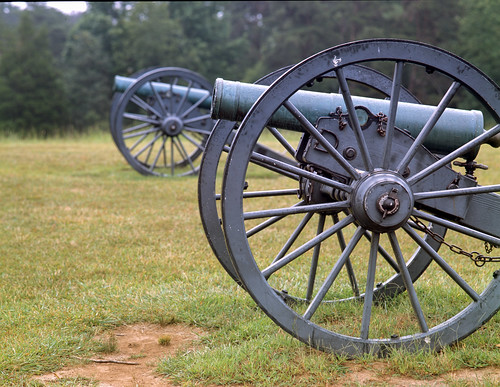Cannon, Manassas Battlefield, by Reed A. George
Bronica ETRS, Fuji Provia film, exposure unrecorded
I live very close to the Manassas National Battlefield, site of two of the deadliest battles of the American Civil War, exactly 150 years ago. I recently decided to take out my Bronica ETRS medium format camera, and Manassas was where I ended up. I've shot this site many times. While there's not really much there in terms of clear photographic subjects, the place has real feeling. It's a little difficult to take a shot of cannons that hasn't been taken before. I don't think I really succeeded with that here, but I do like how the barrels are aligned, with the one in the distance just a little out of focus. That was my goal.
Henry House, Manassas Battlefield, by Reed A. George
Bronica ETRS, Fuji Reala film, exposure unrecorded
One of the few remaining structures from the Civil War era is Henry House. You may remember that I have shot this house before, and won 2nd place in a contest, resulting in the shot being used in the Civil War Trust's 2012 calendar. That image, shot with a Panasonic Lumix DMC-G1, is shown below. The shot above is from the other side of the house.
Henry House, Manassas Battlefield, by Reed A. George
Panasonic Lumix DMC-G1, Leica Elmar 5.0cm f3.5 Lens
High Dynamic Range (HDR) Composite of Multiple Exposures
Finally, on my Bronica outing, I shot the old foundation of a house owned by a free mixed-race person during the Civil War. His name was James Robinson, and his mother was a black woman, and his father was reportedly a member of a prominent white family in the area. In any case, Mr. Robinson was very enterprising, and worked in many different ways to procure himself a piece of land and a house. As you can tell by visiting the remains of the old house, it was quite small. Judging only from memory, I would estimate the foundation to be about 400 square feet. Reportedly, it was a 1 1/2 story building, with the living quarters on the first floor.
Remains of James Robinson's House, Manassas Battlefield, by Reed A. George
Bronica ETRS, Fuji Reala film, exposure unrecorded
Mr. Robinson married an enslaved black woman, which meant by law at the time that there children were also slaves; they had eight together. While Mr. Robinson was able to arrange for some of his children to stay in the Manassas area, at least two of his sons were sold to distant plantations, including one in Louisiana.
For a short biography of Mr. Robinson, (Click Here).
During the first battle at Manassas (also known as "Bull Run") in summer 1861, after hiding under a bridge for the duration of the fight, Mr. Robinson came home to find 13 Confederate dead in his yard. His property had been in the direct path of the retreat from overwhelming Union forces. The Confederates would later push back, inspired by the arrival of Thomas Jackson's forces, routing the Union army and winning an important battle early in the war. This was the battle that earned Jackson his nickname, "Stonewall." Just 13 months later, the house served as a field hospital for the Union army in Second Manassas.
The house burnt down (due to arson) in 1993. While the National Park Service was dismantling the remains, they found an incredible cache of documents from the Robinson family, dating back as far as the 1830s.
I thoroughly enjoyed using the Bronica again. It has been a long time since I took it out. The camera and lenses are large, heavy, and noisy to use. This is no stealth camera. But, the optical performance is very nice. It certainly promotes slow, thoughtful composition. I hope you enjoyed seeing the result.
DMC-365.blogspot.com
I find Fuji Reala (iso 100) film to be very nice for scanning. It is a relatively low contrast color print film. Order yours here:




No comments:
Post a Comment